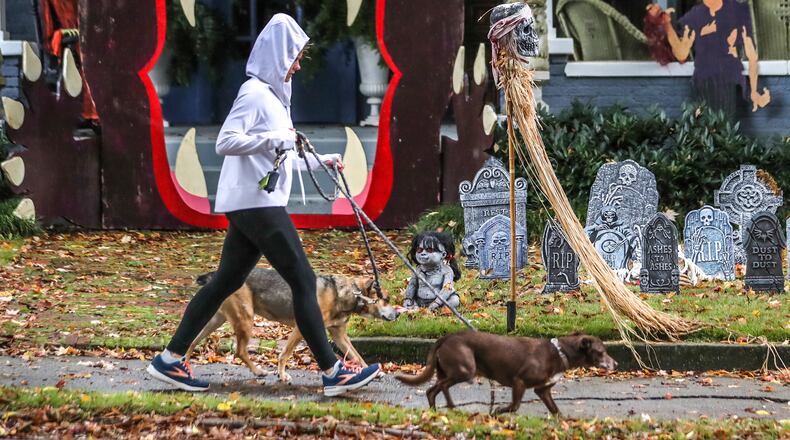Days before the first Halloween I would celebrate in my neighborhood, my friends warned me that our street was one of the more popular for trick-or-treating.
I ran to the store to purchase giant bags of candy and a huge bowl. When I left the house to accompany my child for door-to-door Halloween merriment, I put the bowl on the porch landing and hung a poster-sized sign asking trick-or-treaters to “Please take one!”
Rookie mistake.
My neighbors would later tell me how they tried to prevent the chaos that ensued.
“Just take one please!” they yelled at the kids who stormed the steps and grabbed fistfuls of candy. “Just one!”
When a masked marauder attempted to dump the entire bowl of candy into his plastic trick-or-treat pail, my neighbors intervened. They recovered the candy bowl from my porch, took it to their house and handed out the remaining peanut butter cups and mini chocolate bars, letting everyone know it was candy from the house across the street.
A resident in a nearby neighborhood described a similar event. But the kids, or possibly an adult, didn’t just scoop up all the candy, they took the bowl as well. Her solution? She leaves candy scattered across the porch and lets the kids scamper for it like birds diving for breadcrumbs.
But that was almost 10 years ago and for the past few years, I’ve been left with excess candy. Now I’m begging kids to take more than one piece.
It’s Halloween again and while kids are gearing up for another season of trick-or-treating, not everyone is excited. Each year around this time, we debate whether trick-or-treating is dead, if it should be dead and if there should be an age limit on who can go.
I don’t think the tradition is dead, or that it should be dead, but I know that like many other rituals in American society, trick-or-treating is constantly evolving.
Halloween itself has been through many evolutions. It began as a Celtic pagan festival before the Catholic Church attempted to shift attention away from all things ghoulish or grotesque and place the focus on saints.
After arriving in America as a mashup of traditions, Halloween, at the start of the 20th century, moved away from the religious overtones and became a secular, community-focused celebration. A big part of that shift was reviving the centuries-old practice of trick-or-treating.
Last year, Americans spent $12 billion on goods related to Halloween, a 15% increase from the previous year and a record level of spending that made Halloween the second-largest commercial holiday in the U.S.
But at the same time, an unscientific USA Today poll found almost 75% of respondents said they had fewer trick-or-treaters in 2023 than in the previous year. Weather, other events like trunk-or-treating and safety concerns were cited as possible reasons for the decline.
Safety concerns are also the reason some adults have given up on handing out treats to Halloween tricksters.
“This is a different day and time when it comes to letting kids come to your front door,” said one resident of southeast Atlanta on a Nextdoor thread. “I stopped giving out candy years ago.”
Neighborhoods in the metro area that are considered safe get lots of traffic from trick-or-treaters, while neighborhoods that are considered less safe end up with a candy surplus.
Sometimes the difference is street level.
Grant Park is well-known for its robust trick-or-treating but the hot spots are within the boundaries of Hill Street, Ormond Street and Cherokee Avenue. Wander to the streets north of I-20 and you’ll find yourself in no man’s candy land.
Lately, I’ve noticed an increase in what I call “drive or treat” — adults inching the car down the street as kids jump out to ask for candy instead of parking and walking through the neighborhood.
I thought of a recent Halloween when I dressed as the artist Frida Kahlo and saw a young girl in the same costume trick-or-treating with her family. We laughed and posed for a photo together.
Despite Kahlo’s generally solemn gaze, I am smiling wide in that photo, thrilled by this shared moment that bridged the gap between strangers and generations. It never would have happened if I hadn’t dressed up and stepped outside to take my daughter trick-or-treating.
Trick-or-treating isn’t for everyone, but for those of us who do engage, it can offer a sense of community. The act of spending an evening walking through neighborhoods, asking strangers for candy and doing it with our identities disguised requires a level of trust in other people.
That’s something we could use a lot more of these days.
Read more on the Real Life blog (ajc.com/opinion/real-life-blog/), find Nedra on Facebook (facebook.com/AJCRealLifeColumn) and X (@nrhoneajc) or email her at nedra.rhone@ajc.com.
About the Author






